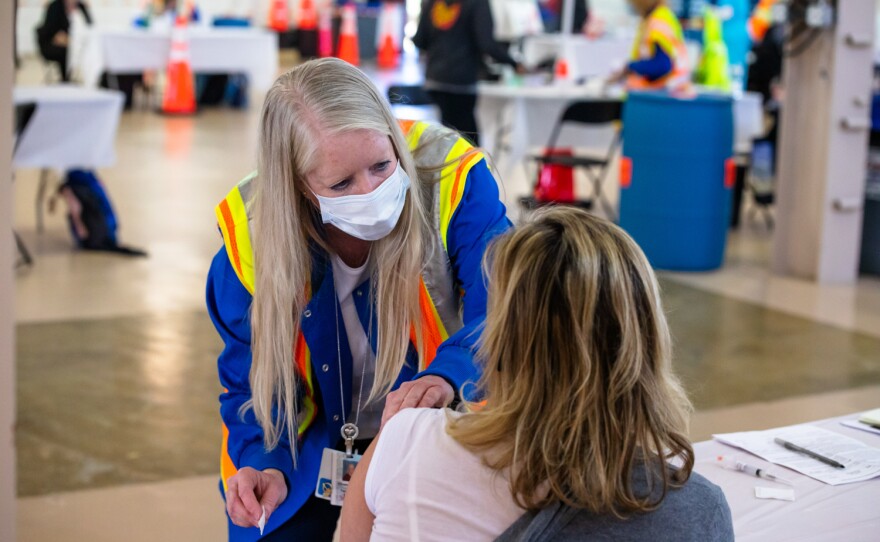People who live in poverty, globally and in Virginia, are bearing the brunt of the COVID-19 pandemic. In the three Richmond ZIP codes with the lowest poverty rates, people are 34% less likely to have been infected than those living in the three ZIP codes with the most poverty.
An inequitable vaccine rollout threatens to push that disparity further.
Though Virginia’s vaccination rate against COVID-19 is relatively high, it remains far short of what’s needed to protect Virginians from the virus that’s killed over 12,000 of us. Making matters worse, places with higher rates of poverty have lower rates of vaccinations. In Richmond, people who have yet to be vaccinated are clustered in areas of high social vulnerability.
Dr. Adnan Hyder, a professor of global health at George Washington University, says to reach segments of the population that have yet to be vaccinated, three types of access must be ensured: geographic access, economic access and cultural access.
“The investment that you want to do is to get, hopefully, all the people eligible to be vaccinated to be 100% vaccinated. That never happens, there’s always a small percentage point. But right now, we have too much of a gap,” Hyder said.
Early vaccine rollout favored wealthier residents
In the early stages of the vaccine rollout, geographic access stood as a major barrier to vaccination. Richmond’s first two mass vaccination sites, Richmond Raceway and the Arthur Ashe Center, were farthest from the city’s Southside and East End, where rates of poverty and COVID-19 cases are disproportionately high.
Since then, the Richmond and Henrico Health Departments have transitioned away from centralized, mass-vaccination clinics in favor of smaller sites in impacted communities.
“We’ve been in churches, we’ve been in salons, we’ve done a few in parks. It’s really been a lot of everything,” said Virginia Slattum, a nurse who’s been administering the COVID-19 vaccine with the department.
Recently, RHHD has added four weekly vaccination hubs to its clinic schedule. Slattum says the hubs, which are spread throughout the city and county, provide consistent places where people can know vaccines are available.
“We will be here at the same location, same times for the foreseeable future,” she said. “It’s much easier for folks, especially by word of mouth.”
One potential shortfall of the hubs is they are primarily open during work hours. That can make it particularly difficult for employees without access to paid sick leave to get vaccinated. President Joe Biden’s plan to require large employers to mandate vaccines, however, would also require them to provide workers with paid time off to get vaccinated in efforts to improve economic access.
Discrimination contemporary and historical fuels mistrust
But cultural access remains a barrier for many Virginians. “You have communities who have centuries of mistrust and distrust of the government, of state, county and national government” Hyder said.
Social trust, which is associated with a host of benefits for a country, has been on the decline in the U.S. since at least the 1970s. Less than a third of Americans surveyed by the National Opinion Research Center in 2018 agreed that most people can be trusted.
Trust in the healthcare system has followed a similar trajectory, and much has been written over the past 12 months about how historic atrocities have specifically harmed trust from Black Americans.
But it isn’t just historic injustices that inform mistrust among Black Americans; the medical system continues to fail them in the present day. Rates of infant and maternal mortality are highest among Black people, and Black Americans are twice as likely to report discrimination from a doctor.
One potential factor: the shortage of Black doctors. While over 13% of Americans identify as Black alone, only 5% of physicians in the U.S. do. Adam Biggs, a history professor at the University of South Carolina Lancaster, says that’s partially to blame on a 1910 report on the administration of medical colleges, the Flexner Report.
It came as part of a larger reform movement within the medical field at the start of the 20th century. At the time, Biggs says, medicine wasn’t nearly as prestigious as it is today and people often didn’t respect doctors’ authority. The reforms were undertaken to repair the field’s image.
“The motivation for this larger reform effort was really not about finding better therapeutic practices,” Biggs said. “It was about limiting access to the profession so that practitioners who were in this organized capacity... could make a living.”
Biggs says many people see this as the moment medicine became modern and turned away from “homeopathic” treatment. He says these reforms did lead to the adoption of more scientific practices, but they also had a chilling effect on access to the occupation.
“When you require more training as an undergraduate and you require more years in medical school, that means that the cost for those types of endeavors go up,” he said. “So if you are poor or you are working class, it is much more difficult for you to actually afford to be able to get a medical education.”
Students weren’t the only ones facing new financial burdens; medical schools in areas with less wealth were asked to invest in new equipment at the same time their potential student base shrank. More than half of medical schools in the U.S. and Canada shut down following the Flexner reforms. Closures disproportionately impacted the U.S South and Black Americans, with five of the seven Black medical schools shut down.
These reforms continue to affect who can become a doctor today, Biggs says, noting that even though medical schools and hospitals were desegregated in the 1960s, the percentage of physicians who identify as Black has hardly changed in the 120 years since the reform movement began.
The lack of access to the medical field drives some of the mistrust towards it, according to Biggs.
“Part of the reason, I think, that you see this level of resistance is because people don’t feel like the folks who are working in the CDC are actually extensions or part of their communities,” he said. “They don’t know many people, if anybody, who has gone on to get a graduate degree in a health-related field.
“That’s not because they’re not smart enough to do it, it’s just because they can’t afford to. I think that’s true with communities in the rural south, and I also think that’s true with African American communities.”
Community health work can repair trust
Much of the reporting on vaccine hesitancy has been based on racist sterotypes. Rural Americans and Republicans are both less likely to report being vaccinated than Black Americans. But within Richmond, the gap is stark.
Just over 6-in-10 white Richmonders have been vaccinated, while that number is about 4.5-in-10 for Black Richmonders. Latino Richmonders are far more likely to be vaccinated, with nearly 3-in-4 having already gotten the shot, largely due to a campaign of community clinics.
Dr. Paul Ndebele, a bioethicist with George Washington University, says it will be key for local public health officials to work with communities to help overcome this mistrust. He says at the end of the day, public health officials must convince people that vaccination will benefit all.
“Such an effort needs to be led by local leaders,” he said. “So that this is seen to be a local effort, not something that is being driven by the Biden administration.
“What we need to do is ensure that public health leadership is actually moving in step with the communities… Those concerns, those suspicions, they need to be discussed openly with the public health and also the political leaders so that in the end, the communities are assured.”
Wornie Reed, a retired sociology professor who heads the Race and Social Policy Research Center at Virginia Tech, agrees with Ndebele that reaching the last people who remain unvaccinated will require a bottom-up approach.
He led a research study in the 1990s in Ohio that asked if people with low incomes were less likely to get their children vaccinated against diseases such as mumps and pertussis. After conducting a census of vaccinations in the three poorest census tracts in each of the eight largest cities in the state, they found vaccination rates were far lower in these areas of concentrated poverty than in the state overall.
Reed argues these differences were due to the effect of reference groups, or the people that an individual interacts with on a day to day. Basically, he says people do what the people around them do. That same effect is playing out today.
“It is no different from lower income than it is from middle income. They do what their reference group does or tells them to do,” he said. “You must, therefore, disrupt this culture found among lower income people. You must disrupt it in some kind of way to get them on board with certain things. The top-down is not necessarily working all that well. It may work for middle-class people, but it doesn’t work as well for people who are lower class.”
Politicians have played their role in helping to foment mistrust in the vaccines as well. In Tennessee, Republican lawmakers backed a proposal to limit public health officials’ ability to encourage children to be vaccinated in a move that mirrors efforts nationwide. Only 32% of Tenesseans under the age of 20 have been fully vaccinated.
While Biggs says much of this can be blamed on rhetoric from former President Donald Trump, the root of the issue lies deeper.
“Trump’s election doesn’t help, but I think that’s more a symptom of the problem than it is actually the problem itself,” he said. “Not that it wasn’t a big part of the problem, but I think it was more of a symptom of the impact of these really extraordinary wealth disparities.”
Those wealth disparities continue to deepen in American society. Between 1983 and 2016, the median family wealth of the richest Americans more than doubled. Wealth for middle-class Americans has hardly risen over the past 40 years, and for the poorest, it’s declined.
Higher levels of income inequality and poverty are noted to decrease social trust. And a 2016 report from the International Monetary Fund found that residual inequality, that which reproduces itself between generations, plays the largest role in driving that trust down.
It should come as no surprise then that the U.S. is struggling to get everyone on board with vaccination.




